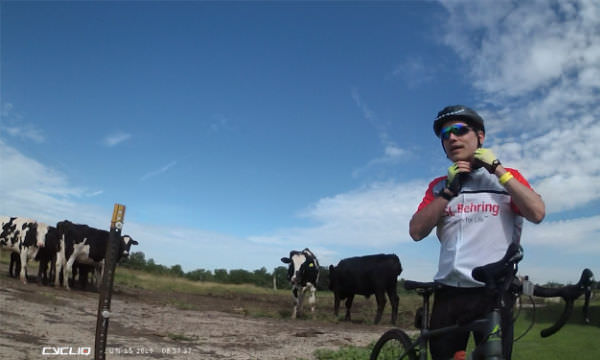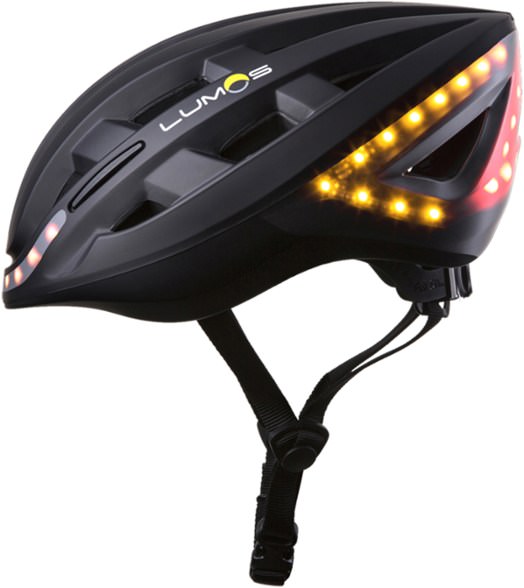This is an objective, non-compensated review of the Lumos Helmet, which was purchased at retail. I have no connection to Lumos.
Santa gave me a Lumos Helmet for Christmas last year. My last helmet, a Giro Atmos II, made the ultimate sacrifice in a high-speed crash last October. I was so impressed with that helmet and how well it protected both my skull and my brain, I went right out and bought another, but Santa thought I could do better.

The main feature (you can call it a gimmick if you want) of the Lumos helmet are the built-in lights, and there are a bunch of them. There are white LEDs in the front which will help you stand out in a dark space, such as under shade trees or in a tunnel. In back, there’s a triangle of red LEDs that do the same job. They’re no substitute for a headlight and rear tail light, but a little extra lighting can’t be a bad thing. I think there’s enough data out there to show that lighting beats reflectivity or bright colors for safety.
The real differentiator of this helmet are yellow turn signals, front and rear, activated by either a set of buttons strapped to the handlebars (boring), or activated by your hand signals, facilitated by your Apple Watch (nerdy-cool). Since you can’t actually see these lights when you’re wearing the helmet, it beeps to tell you whether the turn signals are switching on or off, and the beeps for left and right are different, although you should hopefully know which one you’ve triggered.
Apple Watch / Lumos helmet integration
In practice, the Apple Watch integration works fairly well, but not so well that you aren’t going to get a few wrong signals on each ride. You need to calibrate your Watch, using the same gestures that you’d use while riding (that is, arm straight out for a left turn, held up for a right turn). To turn off the turn signal, you shake your wrist. Running over broken pavement can also trigger the wrist-shake gesture and turn off the turn signal, whether you want to or not. I haven’t check this with Lumos, but I believe that the turn signal turns itself off after some number of seconds, so if you had a feel for that you could learn to signal at the right moment and it would time-out when you wanted to. I haven’t used it enough to get that sort of thing down.
Calibration is a little tricky, and it’s possible I really haven’t done it quite right. You need to be in the same position you will be when riding — if you sit up in the saddle you’re not going to get the same effect. Essentially, you need to be riding while you calibrate (or have someone hold your bike while you get into riding position), which is tricky. Lumos has some suggestions about how to gesture for a turn that works best with the software.
Needless to say, you have to wear your watch on your left wrist for all of this to work. It so happens that I broke my left wrist in the same crash in which I broke my last helmet, so I usually wear my Watch on my right now. I have to remember to switch the Watch to my left if I want to use it with the helmet, which isn’t so convenient (switching wrists with the Apple Watch involved changing a setting on your iPhone). Not much Lumos can do about this, but it’s something to think about if you happen to wear your Apple Watch on your right wrist.
Let me talk pros and cons before I tell you how I feel about the helmet overall…

PROS of the Lumos Helmet
Lighting: The lighting adds just a little bit of visibility, which can’t be a bad thing. In my humble opinion, the helmet is good looking and I don’t feel silly with a bunch of lights on my head. The designers did a good job. I think the turn signals do a very good job of alerting riders and traffic behind you (if maybe just for the novelty of it) but since you have to make the hand gesture anyway, are there really circumstances in which you’re really communicating new information via the helmet lights?
Comfort: SPOILER ALERT — this is probably the #1 reason why I’m still wearing this helmet. It’s actually really comfortable to wear. I read a review of the helmet online in which the reviewer said the helmet was heavy compared to others, and that sounds reasonable given the additional battery and lights that it has. In practice, though, I can’t tell the difference. I haven’t weighed the helmets, but subjectively it feels no heavier.
CONS of the Lumos Helmet
False signals: As I said before, it’s really nifty that with a properly calibrated Apple Watch you can trigger the helmet turn signals just by using the ordinary hand signals, but it’s not perfect. Usually the gesture needs to be just so, and it doesn’t work every time. I’ve even had the helmet signal the wrong turn, not to mention all the times that vibrations from the road canceled a turn prematurely. It’s good, but it’s far from perfect.
Battery life: After about 3½ hours, the batteries in my helmet die, and at that point it’s just a helmet.
Cost: As of this writing, a Lumos helmet costs about $180, which is somewhat steep for a helmet. One crash, and I suppose you need to pony up another $180 for a replacement. Lumos should have a trade-in program that would let you send in your damaged helmet and get the electronics transferred to a new shell. You’d think that would cut the price for replacement somewhat, and it’d help with customer loyalty, too.
Would I buy it again?
In summary, let me try to answer the big question: if I didn’t have one of these helmets, would I spend the money to buy one? I don’t know if I would. After all, I was completely happy with my Giro helmet which was far cheaper, and I’m not convinced that the additional lights are that big of a safety feature. Still, the Lumos helmet is pretty comfortable, and I was just out on their website and saw the new models which look pretty slick. If they’re improving the software as they refine the design of the helmet as a whole, I’d definitely at least give it a look.
One open question
There is a beta feature of the helmet that I’m getting ready to try out, a brake light. As I understand it, the helmet (or maybe it’s your watch) detects your deceleration and makes an appropriate signal. When I got my helmet, the existence of this feature was practically an Easter egg, and wherever I could find reference to it Lumos was emphatic about this being a beta feature. Because of this, I haven’t tried it out, but I really should. If the helmet can detect and signal that I’m slowing, that would be useful. Not everyone (particularly non-bicyclists) recognize the “slow” hand signal, and this would be a novel feature. If I can make a determination of its effectiveness one way or the other, I’ll update this post.

0 Comments